The Belt and Road Initiative Benefits the People
The Belt and Road Initiative Benefits the People*
August 17, 2016
We must review the experience gained and advance the Belt and Road Initiative with full confidence, focusing on policy coordination, connectivity of infrastructure, unimpeded trade, financial integration and closer people-to-people ties, highlighting the establishment of mutually beneficial and cooperative networks, new modes of cooperation, and multilateral cooperation platforms, and joining hands to build a road of green development, of health cooperation, of innovation and of peace. Like driving a nail with a hammer, we should push the initiative forward step by step to ensure peoples along the route benefit from the initiative.
Since the 18th CPC National Congress in 2012, the Central Committee has identified, with an eye to development as planned for the 13th Five-year Plan period (2016-2020) and longer term, three major development strategies: the Belt and Road Initiative, the Coordinated Development of Beijing, Tianjin and Hebei, and the Yangtze River Economic Belt. In 2014 we approved the Strategic Planning for the Building of the Silk Road Economic Belt and the 21st Century Maritime Silk Road. In 2015 we released the "Vision and Actions on Jointly Building Silk Road Economic Belt and the 21st Century Maritime Silk Road", which is to be complemented by local and departmental plans and which has attracted international attention.
At present, more than 100 countries and international organizations have joined the initiative. China has signed cooperation agreements on building the Belt and Road with more than 30 countries, and entered into international industrial cooperation with more than 20 countries. The United Nations and other international organizations have also positively responded to the initiative. There has been further financial cooperation involving the Asian Infrastructure Investment Bank (AIIB), the Silk Road Fund and others, and a number of influential landmark projects have been implemented. The initiative started from scratch, but is now progressing rapidly, yielding rich results beyond expectation.
Only a strong and prosperous country can open itself to the outside world with confidence, and openness in turn promotes further prosperity. China's achievements since the beginning of reform and opening up in 1978 have proved that openness is an important driver of its economic and social development. As China becomes the world's second largest economy and its economy enters the new normal, to maintain sustainable and healthy economic growth we must have a global vision, take a holistic approach to the situation both at home and abroad, and develop a grand and comprehensive opening-up strategy. We must embrace the world in a more proactive manner.
We will take advantage of the initiative to increase transnational connections and communications, and enhance cooperation in trade and investment, and in industry and equipment manufacturing. What is essential is to rebalance the world economy by fostering new demand and ensuring effective supply. Particularly in the current situation where the world economy has remained sluggish, it will help to stabilize the world economy if procyclical industrial and building capacity could be used by participating countries to meet the pressing demand for industrialization, modernization and infrastructure.
To promote the Belt and Road Initiative, first we must build up consensus. We should, through joint planning and shared development for mutual benefit, focus on key regions, countries and projects, concentrate on development, and strive to benefit not only the people of China but also – and more importantly – people from other countries along the route. China welcomes others on board its express train of development. All other countries and international organizations are welcome to join the initiative.
Second, we should ensure well-organized implementation of our plans, and work out measures and policies to promote the initiative. We should focus on innovation, improve supporting services, and give priority to such projects of strategic importance as the connectivity of infrastructure, the development and utilization of energy resources, the building of economic, trade and industrial cooperation zones, and the research and development of core industrial technologies.
Third, we should promote a coordinated and balanced development, between land and sea, between China and foreign countries, and between governments and enterprises. We will encourage Chinese enterprises to invest in other countries along the route, which are also welcome to invest in China. We will strengthen the complementarity between the initiative and national strategies, including the Coordinated Development of Beijing, Tianjin and Hebei, and the Yangtze River Economic Belt. To take a holistic and integrated approach to the initiative on the one hand and other programs on the other, such as the development of west China, the revitalization of northeast China, the rise of central China, earlier starter of east China and the development and opening up of the border regions, we will be able to achieve all-round opening up and integrated development of east, central, and west China.
Fourth, we should launch key projects first. We may start with a few demonstration projects for early harvest, in particular, projects for infrastructure connectivity, cooperation in industrial capacity, and economic and trade zones, so that countries involved will have a true sense of achievement.
Fifth, we should promote financial innovation to facilitate the initiative, creating innovative international financing models, expanding financial cooperation, building multilevel financial platforms, and establishing a financial security system that is enduring, stable, and sustainable, and keeps risks under control.
Sixth, we should foster close people-to-people ties, carry forward the Silk Road spirit, and promote cultural exchanges and mutual learning.
Seventh, we should enhance publicity on the achievements of the initiative and increase academic research, theoretical support, and channels for communications.
Eighth, we should strengthen security, improving risk assessment, monitoring, early warning, and emergency response. We should establish a sound working mechanism and define the implementation steps, so as to ensure that all departments, project management units or enterprises that are involved properly follow the arrangements and measures.
* Main points of the speech at a conference on the Belt and Road Initiative.
(Not to be republished for any commercial or other purposes.)



